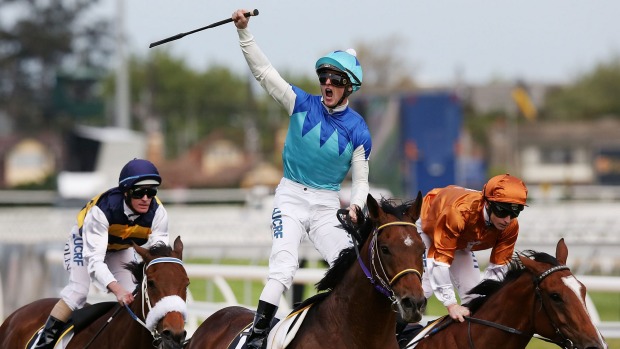The Melbourne Cup is a $6m Group 1 handicap open to horses aged three years or older. It is run over 3200m at Flemington on the first Tuesday of November each year.
It is Australia’s biggest horse race and is widely known as “the race that stops the nation” – although New Zealanders are known to call it “the race that stops two nations”, Australia and New Zealand.

The history of the Melbourne Cup forms an important aspect of Australian folklore. First run in 1861, legend has it the prestigious handicap was the brainchild of Captain Frederick Standish, the Chief Commissioner of Police in the colony of Victoria. Standish, who had arrived in Australia from England a decade prior, was a keen gambler and a prolific racing man. At the time, there were two warring race clubs who both used Flemington – the Victoria Jockey Club and the Victoria Turf Club. Standish, a Turf Club man, advocated a significant betting race “similar to the Chester Cup at home” to be run at the club’s 1861 spring meeting.
At the time, weight for age racing was seen as the only measure of greatness, and many thought Standish to be a foolish dreamer. But right from the first Cup, interest was high, and within a matter of years, its place in Australian history was secure. In 1881, only 20 years after the first Melbourne Cup, a quarter of Melbourne’s population of 400000 was trackside at Flemington.
The first two Melbourne Cups were won by the New South Wales galloper Archer. For many years, it was believed that Archer had walked from the town of Nowra, all the way to Flemington – a journey of more than 800km. However, this was later disproved after shipping records emerged showing him as a traveller. Nevertheless, the Archer myth helped to solidify the wonder of the Melbourne Cup.
He was prevented from winning a third Melbourne Cup in 1863 by a bureaucratic decision not to accept his entry, which arrived late due to a public holiday in Victoria. It was not until 1935 that another horse had the opportunity to go for three Melbourne Cups, when Peter Pan lined up – he finished 13th. The feat was achieved in 2005 when Makybe Diva won her third Melbourne Cup.
Five horses have won more than one Melbourne Cup – Archer (1861, 1862), Peter Pan (1932, 1934), Rain Lover (1968, 1969), Think Big (1974, 1975) and Makybe Diva (2003, 2004, 2005).
In a race where notable performances are the norm, there are certain winners who leap off the page. Take the three year old filly Briseis, who became the only horse to win the Victoria Derby, the Melbourne Cup and the Crown Oaks treble in 1876, or another three year old in Grand Flaneur, whose victory in the 1880 Melbourne Cup was one of nine races he won before he retired undefeated. Malua, in 1886, became the only horse to complete the Oakleigh Plate-Melbourne Cup double, a true mark of versatility (incredible, he would later add the three mile (4800m) VRC Grand National Steeplechase to his record).
Carbine, perhaps the greatest winner of them all, won the Melbourne Cup in 1890 under a crushing 10st 5lb (66kg) in then-record time. Only forty years later, he would be joined in the record books by Phar Lap, the hope of a nation in the midst of the Great Depression. His 1930 Melbourne Cup victory, more than any other, holds a special place among the nation’s sporting annals.
The recent history of the Melbourne Cup has been dominated by J.B. Cummings, better known to the public at large simply as Bart. The man who had his first sniff of Melbourne Cup glory when he strapped Comic Court, a horse trained by his father Jim, has a record in the Cup which is unlikely to be matched. He has trained 12 winners – Light Fingers (1965), Galilee (1966), Red Handed (1967), Think Big (1974, 1975), Gold and Black (1977), Hyperno (1979), Kingston Rule (1990), Let’s Elope (1991), Saintly (1996), Rogan Josh (1999) and Viewed (2008).
Throughout the 1970’s and 1980’s, the quality of the race was falling away, particularly at the lower end of the weight scale. However, international participation in the Melbourne Cup has revitalised the race, to the point where it is now recognised as one of the world’s great races.
Internationals first participated in the Melbourne Cup in 1993, with the initial raid led by England’s Drum Taps and Ireland’s Vintage Crop. At their first attempt, they walked away victorious, with Vintage Crop a dominant winner for Dermot Weld. Despite predictions that the internationals would win every year, it was not until 2002 that they would win again – and once more, it was Weld who was successful with Media Puzzle.
In 2006, Japan tasted its first – and to date, only – success when Delta Blues nosed out compatriot Pop Rock, while France won Melbourne Cups with Americain in 2010 and Dunaden in 2011. The United Kingdom is yet to win the race, despite numerous close calls. English horses were beaten by a nostril in 2008 and 2011.
Perhaps a greater testament to the nature of the race is a list of the horses that have tried and failed to win the world’s richest handicap – the likes of Wakeful, Manfred, Beau Vite, Hydrogen, Redcraze, Tulloch, Tobin Bronze, Gunsynd, Kingston Town, Super Impose and So You Think.
Many of them had excuses, but that is the beauty of a handicap – it allows every horse an opportunity to win if the cards fall the right way. Take 1903, when the champion mare Wakeful was aiming to end her career on the highest possible note. In the end, she finished a game second to Lord Cardigan, to whom she was conceding an incredible 22kg. On class, there was no comparison, but the handicap suited Lord Cardigan.
The stature of the Melbourne Cup continues to grow worldwide, and while it has lost much of its shine as a true handicap due to the calibre of thoroughbred it attracts, it continues to stop the nation each first Tuesday in November, just as it has done for more than 150 years.
View the latest Melbourne Cup Info at justhorseracing.com.au
Last Years Melbourne Cup:


